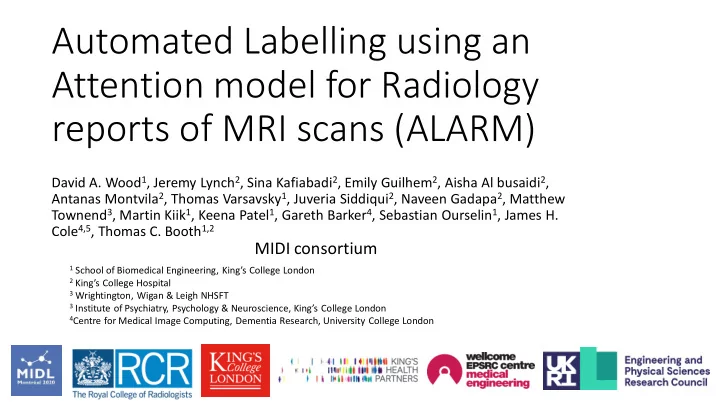

Automated Labelling using an Attention model for Radiology reports of MRI scans (ALARM) David A. Wood 1 , Jeremy Lynch 2 , Sina Kafiabadi 2 , Emily Guilhem 2 , Aisha Al busaidi 2 , Antanas Montvila 2 , Thomas Varsavsky 1 , Juveria Siddiqui 2 , Naveen Gadapa 2 , Matthew Townend 3 , Martin Kiik 1 , Keena Patel 1 , Gareth Barker 4 , Sebastian Ourselin 1 , James H. Cole 4,5 , Thomas C. Booth 1,2 MIDI consortium 1 School of Biomedical Engineering, King’s College London 2 King’s College Hospital 3 Wrightington, Wigan & Leigh NHSFT 3 Institute of Psychiatry, Psychology & Neuroscience, King’s College London 4 Centre for Medical Image Computing, Dementia Research, University College London
Background • Labelling training datasets is a rate-limiting step for clinical deep learning applications • Laborious task requiring considerable domain knowledge and experience i.e. neuroradiologist -
Automatic labelling with NLP • Promising alternative – derive labels from radiology reports using natural language processing -
Automatic labelling with NLP • Promising alternative – derive labels from radiology reports using natural language processing - MIDI consortium
Automatic labelling with NLP • Previously demonstrated for head computed tomography reports (Zech et al. 2018) • No dedicated MRI neuroradiology report classifier • MRI higher soft tissue contrast, so more detailed descriptions – difficult NLP task • Reports contain abbreviations, list of absent abnormalities, abnormalities considered insignificant
Example reports
Example reports
Example reports
BioBERT • Need sophisticated language model trained on relatively few labelled reports • Fine-tune BioBERT, transformer-based biomedical language model • Inherit low level language comprehension i.e. transfer learning • See “The illustrated Transformer” by Jay Alammar for introduction to transformers From Lee et al., 2019
Model • BioBERT converts text to contextualised word embeddings • Downstream classification can be performed by aggregation of embeddings • CLS, max, average, attention weighted
Model - Downstream classification can be performed by aggregation of embeddings - CLS, max, average, attention weighted
Model Model
Model
Data and report labelling • > 120, 000 radiology reports and corresponding MRI scans obtained • 3000 randomly selected for labelling by team of neuroradiologists for model training and validation • 1000 reports labelled into 5 clinically relevant granular categories: - Mass e.g. tumour - Vascular abnormality e.g. aneurysm - Damage e.g. previous brain injury - Acute stroke - Fazekas small vessel disease score • 2000 reports labelled for presence or absence of any abnormality (on the basis of criteria defined by team over the course of 6 months of practice experiments)
Results - Binary classification i.e. normal/abnormal t-SNE visualisation of test set report embeddings Frozen BioBERT Our model word2vec
Results - Granular classification • NLP labelling on basis of reports comparable to expert neuroradiologist • Do reports agree with images? normal/abnormal - yes, granular - mostly (see Wood et al. 2020) • 120, 000 MRI images labelled in < 0.5 hours
Results - Granular classification • NLP labelling on basis of reports comparable to expert neuroradiologist • Do reports agree with images? normal/abnormal - yes, granular - mostly (see Wood et al. 2020) • 120, 000 MRI images labelled in < 0.5 hours MIDI consortium
Interpretability • Inspection of attention weights allows form of model interpretability
Semi-supervised labelling • Pathology-dependent clustering in predicted binary labels allows semi- supervised labelling of granular datasets (e.g. Alzheimer’s, high grade glioma etc.) • “Lasso” too available at https://github.com/tomvars/sifter
Conclusion • Dedicated MRI neuroradiology report classifier for automatic image labelling • Binary classification performance outperforms trained neurologist • Granular classification performance comparable to experienced neuroradiologist • 120,000 radiology reports and corresponding MRI scans labelled in < 0.5 hours Acknowledgements This work was supported by The Royal College of Radiologists, King’s College Hospital Research and Innovation, King’s Health Partners Challenge Fund and the Wellcome/Engineering and Physical Sciences Research Council Center for Medical Engineering (WT 203148/Z/16/Z). We also thank Joe Harper, Justin Sutton, Mark Allin and Sean Hannah at KCH for their informatics and IT support, Ann-Marie Murtagh at KHP for research process support, and KCL administrative support, particularly from Denise Barton and Patrick Wong.
Recommend
More recommend